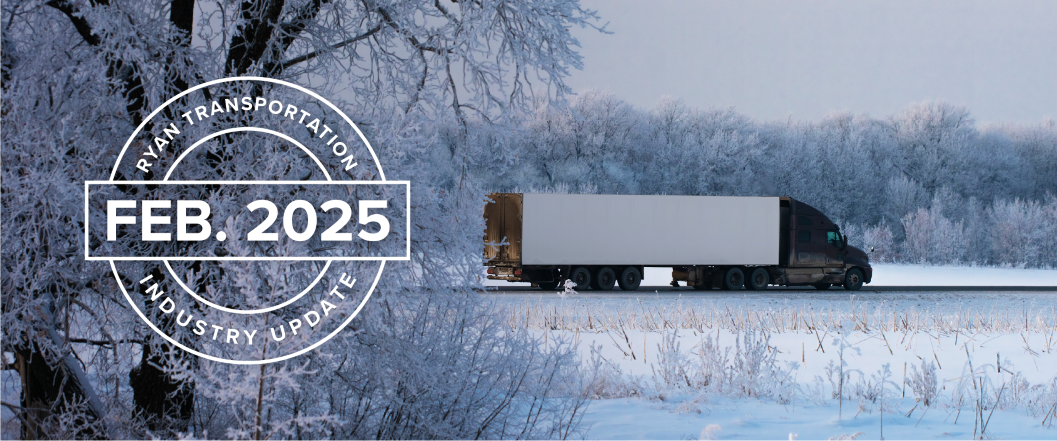
Executive Summary
Despite a turbulent start to the new year, trends in the overall transportation industry have continued to reflect those throughout the broader economy. The mixed, but mostly positive, economic indicators have been shrouded in uncertainty across headlines regarding the workings and policy proposals of the new administration in Washington. At the forefront of all that uncertainty stands trade policy, whose ripple effects will undoubtedly have a significant impact on transportation as a whole, should they be implemented.
Positive development from January included the domestic manufacturing sector emerging from 27 months of contraction and signaling a return to growth. This resurgence was driven by increased demand and production, while employment levels remained stable. The preliminary estimate for Q4 2024 Gross Domestic Product (GDP) indicated an annualized growth rate of 2.3% quarter-over-quarter, down from the robust 3.1% growth recorded in Q3 and slightly below the 2.5% consensus forecast. Economic expansion was largely supported by sustained consumer and government spending, though partially offset by declines in inventories and nonresidential fixed investments. For the full year of 2024, U.S. GDP grew by 2.8%, slightly below the 2.9% recorded in 2023, with consumer and government expenditures and investments serving as the primary growth drivers.
The labor market demonstrated continued stability, with payroll employment increasing by 143,000 jobs in January, while the unemployment rate declined to 4%. However, January’s job gains were tempered by downward revisions to prior months, with December’s employment figures revised downward by 610,000 jobs following the Bureau of Labor Statistics’ (BLS) annual benchmark adjustments. Despite this, December’s revised employment gain stood at 307,000 – higher than the initial estimate of 256,000 – while November’s payroll employment was also revised upward to 261,000 jobs from the previously reported 212,000.
Within the transportation sector, truckload operations continued to face cyclical and structural challenges in January, though signs of stabilization are emerging. Holiday-related disruptions and winter storms, similar to those experienced in January 2024, temporarily increased capacity demand, preventing rates from fully aligning with seasonal expectations. Meanwhile, rail transportation demonstrated resilience, with intermodal volume gains driving overall sector growth. U.S. container imports reached a record high for the month of January, totaling 2,487,470 twenty-foot equivalent units (TEUs), surpassing the previous record set in January 2022 by 21,455 TEUs.
Industry Overview
January Key Figures (YoY)
| Truck Data Points | YoY% Change |
| DAT Spot Rates (incl. FSC) | 0.0 — |
| Fuel Prices | -5.7 q |
| ACT Class 8 Preliminary Orders | 5.1 q |
| ATA NSA Truck Tonnage | -3.2 q |
| Cass Freight Index | -0.4 q |
| Cass Freight Shipments | -6.5 q |
| Cass Freight Expenditures | -3.4 q |
*Report released on 1/21/2025
**Report released on 1/14/2025
Main Takeaways
Economy
Domestic manufacturing returned to growth in January following 26 months of contraction, driven by strong new orders and production. Continue reading...
Truckload Rates
Average spot rates continued their streak of gains in January while contract rates remained stable, further narrowing the contract-to-spot spread. Continue reading...
Truckload Demand
Multiple disruptions during the month led to gains in market share for spot freight while contract volumes returned to more normal seasonal patterns. Continue reading...
Truckload Supply
Tender rejections retreated from holiday highs but remained elevated as winter storms delayed drivers returning to the road. Continue reading...
Truckload Capacity Outlook
Capacity exits continued to slow as market conditions become more stable. Continue reading...
Fuel
Average diesel prices rose sharply in January driven by cold weather and tightening global inventories. Continue reading...
Dry Van
Weather disruptions forced rates higher while dry van volumes lacked similar gains observed across the other major modes. Continue reading...
Reefer
Freezing temperatures led to a surge in reefer demand, driving rates up with it. Continue reading...
Flatbed
Despite minimal growth in overall volumes, flatbed demand surged as cold weather limited outdoor loadings. Continue reading...
Intermodal
Rail activity remained mixed with strong intermodal volumes outperforming volatility in sector-specific carload volumes. Continue reading...
Further Reading
- Tariff Impact Threatens Critical Trucking Sectors | Transport Topics
- Intermodal Volumes Finish 2024 with Solid Growth, Reports IANA | Logistics Management
- Cargo Theft Activity Set New Highs in 2024 | DC Velocity